ABIT AB9-QUADGT User Manual
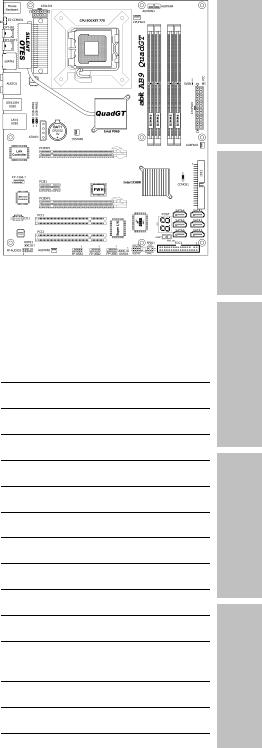
AB9 QuadGT
Motherboard
Socket 775
Intel Core 2 Quad / Core 2 Duo / Core 2 Extreme / Pentium Dual Core / Pentium Extreme / Pentium D / Pentium 4
User’s Manual
About this Manual:
This user’s manual contains all the information you may need for setting up this motherboard. To read the user’s manual of PDF format (readable by Adobe Reader), place the “Driver & Utility CD” into the CD-ROM drive in your system. The auto-run screen will appear, click the “Manual” tab to enter its submenu. If not, browse the root directory of the CD-ROM via the File Manager, and double click the “AUTORUN” file.
LGA775 ATX
Intel P965 / ICH8R
FSB 1066/800/533 MHz
Dual DDR2 800
Dual PCI-E X16 Graphics Slots
Gigabit LAN
8x SATA 3Gb/s with RAID
IEEE1394
7.1 Channel HD Audio
uGuru™ Technology
Silent OTES™ Technology
External CMOS Clearing
Switch
Quick Power & Reset Button
Vista HW Ready
Appendix QIG Multilingual Utility & Driver Setup BIOS Setup Hardware

AB9 QuadGT
User’s Manual
English + Multilingual QIG
2nd Edition, January 2007
Copyright and Warranty Notice
The information in this document is subject to change without notice and does not represent a commitment on part of the vendor, who assumes no liability or responsibility for any errors that may appear in this manual.
No warranty or representation, either expressed or implied, is made with respect to the quality, accuracy or fitness for any particular part of this document. In no event shall the manufacturer be liable for direct, indirect, special, incidental or consequential damages arising from any defect or error in this manual or product.
Product names appearing in this manual are for identification purpose only and trademarks and product names or brand names appearing in this document are the property of their respective owners.
This document contains materials protected under International Copyright Laws. All rights reserved. No part of this manual may be reproduced, transmitted or transcribed without the expressed written permission of the manufacturer and authors of this manual.
If you do not properly set the motherboard settings, causing the motherboard to malfunction or fail, we cannot guarantee any responsibility.
ii |
AB9 QuadGT |

Contents
1. Hardware Setup ............................................................... |
1-1 |
|
1.1 |
Specifications............................................................................... |
1-1 |
1.2 |
Motherboard Layout ..................................................................... |
1-2 |
1.3 |
Choosing a Computer Chassis ....................................................... |
1-3 |
1.4 |
Installing Motherboard ................................................................. |
1-3 |
1.5 |
Checking Jumper Settings............................................................. |
1-4 |
|
1.5.1 CMOS Memory Clearing Header and Backup Battery .............. |
1-4 |
|
1.5.2 Wake-up Header ................................................................. |
1-6 |
1.6 |
Connecting Chassis Components ................................................... |
1-7 |
|
1.6.1 ATX Power Connectors......................................................... |
1-7 |
|
1.6.2 Front Panel Switches & Indicators Headers ........................... |
1-8 |
|
1.6.3 FAN Power Connectors ........................................................ |
1-9 |
|
1.6.4 abit Silent OTES™ Technology .............................................. |
1-9 |
1.7 |
Installing Hardware.................................................................... |
1-10 |
|
1.7.1 CPU Socket 775................................................................. |
1-10 |
|
1.7.2 DDR2 Memory Slots........................................................... |
1-12 |
|
1.7.3 PCI Express X16 Add-on Slots (Install Graphics Card) .......... |
1-13 |
1.8 |
Connecting Peripheral Devices .................................................... |
1-15 |
|
1.8.1 Floppy and IDE Disk Drive Connectors ................................ |
1-15 |
|
1.8.2 Serial ATA Connectors ....................................................... |
1-16 |
|
1.8.3 Additional USB 2.0 Port Headers......................................... |
1-17 |
|
1.8.4 Additional IEEE1394 Port Header........................................ |
1-17 |
|
1.8.5 Internal Audio Connectors.................................................. |
1-18 |
|
1.8.6 Front Panel Audio Connection Header ................................. |
1-18 |
|
1.8.7 S/PDIF Output Connection Header...................................... |
1-20 |
|
1.8.8 PCI and PCI Express X1 Slot............................................... |
1-20 |
|
1.8.9 Guru Panel Connection Header........................................... |
1-21 |
1.9 |
Onboard Indicators and Buttons.................................................. |
1-22 |
|
1.9.1 POST Code Displayer ......................................................... |
1-22 |
|
1.9.2 Power Source Indicators .................................................... |
1-23 |
|
1.9.3 Onboard Buttons ............................................................... |
1-23 |
1.10 Connecting Rear Panel I/O Devices ........................................... |
1-24 |
|
2. BIOS Setup....................................................................... |
2-1 |
|
2.1 |
μGuru™ Utility .............................................................................. |
2-2 |
|
2.1.1 OC Guru ............................................................................. |
2-2 |
|
2.1.2 ABIT EQ.............................................................................. |
2-4 |
2.2 |
Standard CMOS Features............................................................ |
2-10 |
2.3 |
Advanced BIOS Features ............................................................ |
2-13 |
2.4 |
Advanced Chipset Features......................................................... |
2-16 |
|
|
|
AB9 QuadGT |
iii |
|
Appendix QIG Multilingual Utility & Driver Setup BIOS Setup Hardware
2.5 |
Integrated Peripherals................................................................ |
2-17 |
|
2.6 |
Power Management Setup .......................................................... |
2-20 |
|
2.7 |
PnP/PCI Configurations .............................................................. |
2-23 |
|
2.8 |
Load Fail-Safe Defaults............................................................... |
2-24 |
|
2.9 |
Load Optimized Defaults............................................................. |
2-24 |
|
2.10 |
Set Password ........................................................................... |
2-24 |
|
2.11 |
Save & Exit Setup..................................................................... |
2-24 |
|
2.12 |
Exit Without Saving .................................................................. |
2-24 |
|
3. Driver & Utility ................................................................. |
3-1 |
|
3.1 |
CD-ROM AUTORUN ...................................................................... |
3-1 |
3.2 |
Intel Chipset Software Installation Utility ....................................... |
3-2 |
3.3 |
Intel Matrix Storage Manager........................................................ |
3-2 |
3.4 |
Audio Driver ................................................................................ |
3-3 |
3.5 |
LAN Driver................................................................................... |
3-4 |
3.6 |
JMicron SATA Driver..................................................................... |
3-4 |
3.7 |
USB 2.0 Driver ............................................................................. |
3-4 |
3.8 |
ABIT μGuru Utility ........................................................................ |
3-5 |
3.9 |
Build Intel SATA RAID Driver Disk Under Windows Environment ..... |
3-6 |
3.10 Build JMicron SATA RAID Driver Disk Under Windows Environment |
||
........................................................................................................ |
|
3-7 |
3.11 Build A Driver Disk Under DOS Environment ................................ |
3-8 |
|
4. Multilingual Quick Installation Guide .............................. |
4-1 |
|
4.1 |
Français//Guide d'Installation Rapide............................................. |
4-1 |
4.2 |
Deutsch//Kurze Installationsanleitung............................................ |
4-2 |
4.3 |
Italiano//Guida all’installazione rapida ........................................... |
4-3 |
4.4 |
Español//Guía rápida de instalación............................................... |
4-4 |
4.5 |
Português//Guia de instalação rápida ............................................ |
4-5 |
4.6 |
Русский//Краткое руководство по установке .............................. |
4-6 |
4.7 |
Eesti//Kiirpaigaldusjuhend ............................................................ |
4-7 |
4.8 |
Latviski//Ātrās instalēšanas instrukcija........................................... |
4-8 |
4.9 |
Lietuvių//Trumpas instaliavimo vadovas ........................................ |
4-9 |
4.10 |
Polski//Instrukcja szybkiej instalacji........................................... |
4-10 |
4.11 |
Magyar//Gyorstelepítési útmutató.............................................. |
4-11 |
4.12 |
Türkçe//Hızlı Kurulum Kılavuzu.................................................. |
4-12 |
4.13 اللغة العربية//دليل التركيب السريع....................... |
4-13 |
|
4.14 |
فارسی// راﻩنمای نصب سریع............................................... |
4-14 |
4.15 |
// ...................................... |
4-15 |
4.16 |
// ....................................................... |
4-16 |
4.17 |
Bahasa Malaysia//Panduan Pemasangan Ringkas ....................... |
4-17 |
4.18 |
// ........................................................ |
4-18 |
|
|
|
iv |
|
AB9 QuadGT |

4.19 ................................................................................. |
4-19 |
4.19.1 ............................................................................... |
4-19 |
4.19.2 .................................................................. |
4-20 |
4.20 ................................................................................. |
4-21 |
4.20.1 ............................................................................... |
4-21 |
4.20.2 .................................................................. |
4-22 |
5. Appendix .......................................................................... |
5-1 |
|
5.1 |
POST Code Definitions.................................................................. |
5-1 |
|
5.1.1 AWARD POST Code Definitions............................................. |
5-1 |
|
5.1.2 AC2005 POST Code Definitions............................................. |
5-4 |
5.2 |
Troubleshooting (How to Get Technical Support?).......................... |
5-5 |
|
5.2.1 Q & A ................................................................................. |
5-5 |
|
5.2.2 Technical Support Form....................................................... |
5-8 |
|
5.2.3 Universal ABIT Contact Information...................................... |
5-9 |
|
|
|
AB9 QuadGT |
v |
Appendix QIG Multilingual Utility & Driver Setup BIOS Setup Hardware

vi |
AB9 QuadGT |

1. Hardware Setup
1.1 Specifications
|
|
• |
2x |
PCI slots |
|
CPU |
|||||
|
|
|
|
||
• LGA775 socket for Intel Core 2 Quad / |
|
Internal I/O Connectors |
|||
Core 2 Duo / Core 2 Extreme / |
|
• |
1x |
Floppy port |
|
Pentium Dual Core / Pentium Extreme / |
|
• 1x ATA 100 IDE connector |
|||
Pentium D / Pentium 4 |
|
||||
|
• 6x SATA 3Gb/s connectors |
||||
• FSB 1066/800/533 MHz |
|
||||
|
• 3x USB 2.0 headers |
||||
|
|
||||
|
|
• |
1x |
IEEE1394 header |
|
Chipset |
|
||||
• Intel P965 / ICH8R |
|
• 1x FP-Audio header |
|||
|
• 1x CD-In connector |
||||
|
|
||||
Memory |
|
• |
1x |
S/PDIF Out header |
|
• 4x 240-pin DIMM slots support |
|
• |
1x |
GURU header |
|
maximum memory capacity up to 8GB |
|
|
|
|
|
|
Rear Panel I/O |
||||
• Supports Dual Channel DDR2 |
|
||||
|
|
|
|
||
800/667/533 Un-buffered Non-ECC |
|
• |
1x |
PS/2 Keyboard connector |
|
memory |
|
• 1x PS/2 Mouse connector |
|||
|
|
||||
|
|
• 1x External CMOS Clearing Switch |
|||
LAN |
|||||
|
• 1x S/PDIF In connector |
||||
• Onboard 10/100/1000M PCI Gigabit |
|
||||
|
• |
1x |
S/PDIF Out connector |
||
controller |
|
||||
|
|
• |
2x eSATA connectors |
||
Audio |
|
• |
1x |
7.1CH Audio connector |
|
• Onboard 7.1 CH HD Audio CODEC |
|
• |
4x |
USB 2.0 connectors |
|
• Supports auto jack sensing and optical |
|
• |
1x |
IEEE1394 connector |
|
S/PDIF In/Out |
|
• |
1x |
RJ-45 Gigabit LAN connector |
|
• HDMI Header ready (S/PDIF Header) |
|
|
|
|
|
|
|
abit Engineered |
|||
Serial ATA |
|
• |
abit uGuru™ Technology |
||
• 6x SATA 3Gb/s offered by Intel ICH8R |
|
• |
abit Silent OTES™ Technology |
||
support Intel Matrix Storage Tech (AHCI |
|
• External CMOS Clearing Switch |
|||
& RAID 0, 1, 5, and 10) |
|
||||
|
• Quick Power & Reset Button |
||||
• 2x SATA 3Gb/s offered by JMicron |
|
||||
|
|
|
|
||
JMB363 support RAID 0, 1, and JBOD |
|
|
|
|
|
|
RoHS |
|
|||
|
|
|
|||
|
|
• |
100% Lead-free process and RoHS |
||
IEEE1394 |
|||||
• Supports 2 Ports IEEE1394 at 400Mb/s |
|
|
compliant |
||
|
|
|
|
||
transfer rate |
|
|
|
|
|
|
Miscellaneous |
||||
|
|
||||
|
|
• |
ATX form factor (305mm x 245mm) |
||
Expansion Slots |
|||||
• 1x PCI-E X16 slot (x16 bandwidth) |
|
• |
Vista HW Ready |
||
|
|
|
|
||
•1x PCI-E X16 slot (x4 bandwidth)
•1x PCI-E X1 slot
Specifications and information contained herein are subject to change without notice.
AB9 QuadGT |
1-1 |
Setup Hardware
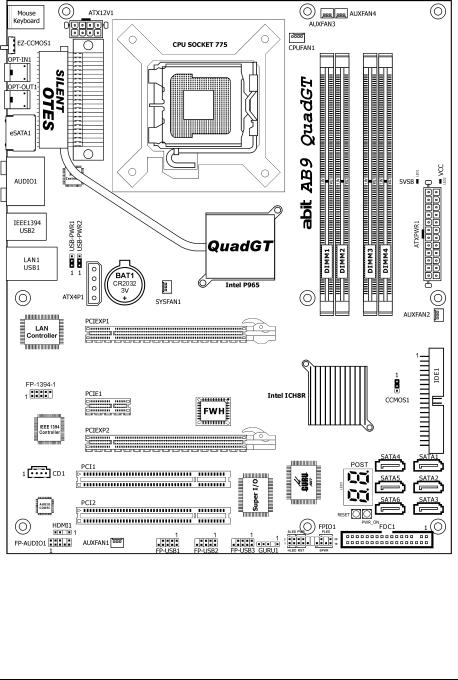
1.2 Motherboard Layout
1-2 |
AB9 QuadGT |

1.3 Choosing a Computer Chassis
•Choose a chassis big enough to install this motherboard.
•As some features for this motherboard are implemented by cabling connectors on the motherboard to indicators and switches or buttons on the chassis, make sure your chassis supports all the features required.
•If there is a possibility of adopting some more hard drives, make sure your chassis has sufficient power and space for them.
•Most chassis have alternatives for I/O shield located at the rear panel. Make sure the I/O shield of the chassis matches the I/O port configuration of this motherboard. You can find an I/O shield specifically designed for this motherboard in its package.
1.4 Installing Motherboard
Most computer chassis have a base with many mounting holes to allow the motherboard to be securely attached, and at the same time, prevent the system from short circuits. There are two ways to attach the motherboard to the chassis base: (1) with studs, or (2) with spacers.
Basically, the best way to attach the board is with studs. Only if you are unable to do this
should you attach the board with spacers. Line up the holes on the board with the mounting holes on the chassis. If the holes line up and there are screw holes, you can attach the board with studs. If the holes line up and there are only slots, you can only attach with spacers. Take the tip of the spacers and insert them into the slots. After doing this to all the slots, you can slide the board into position aligned with slots. After the board has been positioned, check to make sure everything is OK before putting the chassis back on.
Always power off the computer and unplug the AC power cord before adding or removing any peripheral or component. Failing to so may cause severe damage to your motherboard and/or peripherals. Plug in the AC power cord only after you have carefully checked everything.
To install this motherboard: |
|
|
1. |
Locate all the screw holes on the |
|
|
motherboard and the chassis base. |
|
2. |
Place all the studs or spacers needed on |
panel. |
|
the chassis base and have them tightened. |
|
|
|
|
3. |
Face the motherboard’s I/O ports toward |
rear |
|
the chassis’s rear panel. |
|
|
|
|
4. |
Line up all the motherboard’s screw holes |
chassis’s |
|
have them tightened. |
|
|
with those studs or spacers on the chassis. |
|
5. |
Install the motherboard with screws and |
|
|
To prevent shorting the PCB circuit, |
the |
|
please REMOVE the metal studs or |
Face |
|
spacers if they are already fastened |
|
|
on the chassis base and are without |
|
|
mounting-holes on the motherboard |
|
|
to align with. |
|
|
|
|
AB9 QuadGT |
1-3 |
|
Setup Hardware
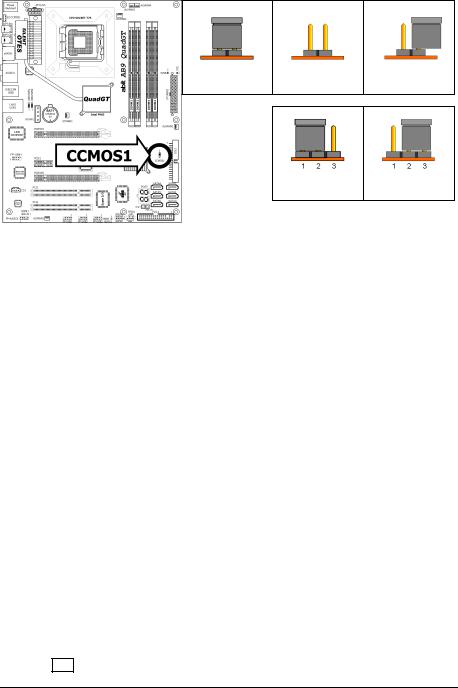
1.5 Checking Jumper Settings
•For a 2-pin jumper, plug the jumper cap on both pins will make it CLOSE (SHORT).
Remove the jumper cap, or plug it on either pin (reserved for future use) will
leave it at OPEN position. |
SHORT |
OPEN |
OPEN |
•For 3-pin jumper, pin 1~2 or pin 2~3 can be shorted by plugging the jumper cap in.
Pin 1~2 SHORT Pin 2~3 SHORT
1.5.1 CMOS Memory Clearing Header and Backup Battery
The time to clear the CMOS memory occurs when (a) the CMOS data becomes corrupted, (b) you forgot the supervisor or user password preset in the BIOS menu,
(c) you are unable to boot-up the system because the CPU ratio/clock was incorrectly set in the BIOS menu, or (d) whenever there is modification on the CPU or memory modules.
This header uses a jumper cap to clear the CMOS memory and have it reconfigured to the default values stored in BIOS.
•Pins 1 and 2 shorted (Default): Normal operation.
•Pins 2 and 3 shorted:
Clear CMOS memory.
To clear the CMOS memory and load in the default values:
1.Power off the system.
2.Set pin 2 and pin 3 shorted by the jumper cap. Wait for a few seconds. Set the jumper cap back to its default settings --- pin 1 and pin 2 shorted.
3.Power on the system.
4.For incorrect CPU ratio/clock settings in the BIOS, press <Del> key to enter the BIOS setup menu right after powering on system.
5.Set the CPU operating speed back to its default or an appropriate value.
6.Save and exit the BIOS setup menu.
Another easy way to clear the CMOS memory can be done by switching “EZ-CCMOS1”, see the section of “Connecting Rear Panel I/O Devices” in this manual for detail.
The C.C. POST Code appears when either the external “EZ-CCMOS1” switch or the internal “CCMOS1” jumper is not set to its normal position.
1-4 |
AB9 QuadGT |
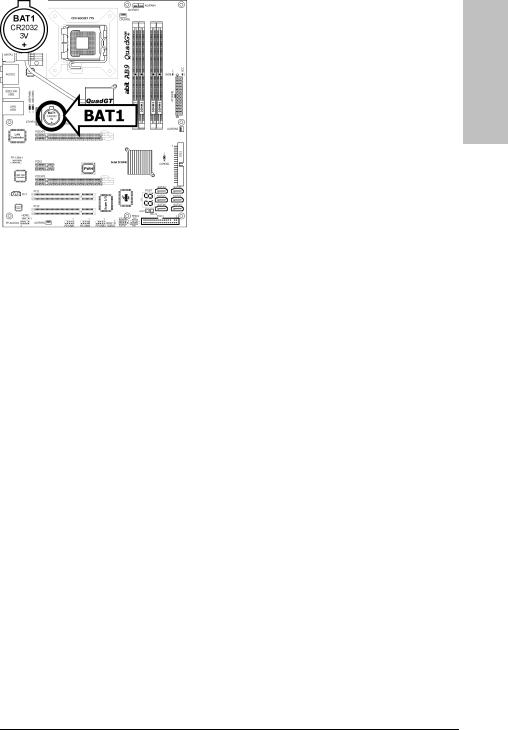
CMOS Backup Battery:
An onboard battery saves the CMOS memory to keep the BIOS information stays on even after disconnected your system with power source. Nevertheless, this backup battery exhausts after some five years. Once the error message like “CMOS BATTERY HAS FAILED” or “CMOS checksum error” displays on monitor, this backup battery is no longer functional and has to be renewed.
To renew the backup battery:
1.Power off the system and disconnect with AC power source.
2.Remove the exhausted battery.
3.Insert a new CR2032 or equivalent battery. Pay attention to its polarity. The “+” side is its positive polarity.
4.Connect AC power source and power on the system.
5.Enter the BIOS setup menu. Reconfigure the setup parameters if necessary.
CAUTION:
Danger of explosion may arise if the battery is incorrectly renewed.
Renew only with the same or equivalent type recommended by the battery manufacturer.
Dispose of used batteries according to the battery manufacturer’s instructions.
Setup Hardware
AB9 QuadGT |
1-5 |
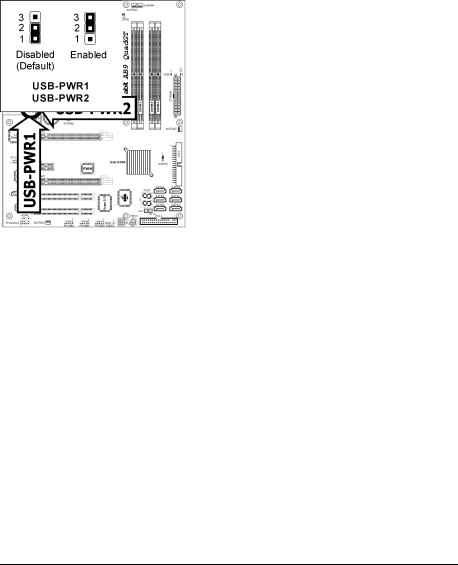
1.5.2 Wake-up Header
These headers use a jumper cap to enable/disable the wake-up function.
•USB-PWR1:
Pin 1-2 shorted (Default): Disable wake-up function support at USB1 port. Pin 2-3 shorted: Enable wake-up function support at USB1 port.
•USB-PWR2:
Pin 1-2 shorted (Default): Disable wake-up function support at USB2 port. Pin 2-3 shorted: Enable wake-up function support at USB2 port
1-6 |
AB9 QuadGT |

1.6 Connecting Chassis Components
1.6.1 ATX Power Connectors
These connectors provide the connection from an ATX power supply. As the plugs from the power supply fit in only one orientation, find the correct one and push firmly down into these connectors.
ATXPWR1: ATX 24-Pin Power Connector
The power supply with 20-pin or 24-pin cables can both be connected to this 24-pin connector. Connect from pin-1 for either type. However, a 20-pin power supply may cause the system unstable or even unbootable for the sake of insufficient electricity. A minimum power of 300W or higher is recommended.
ATX12V1: ATX 12V 8-Pin Power Connector
This connector supplies power to CPU. The system will not start without connecting power to this one.
ATX4P1: Auxiliary 12V Power Connector
This connector provides an auxiliary power source for devices added on PCI Express slots.
Setup Hardware
AB9 QuadGT |
1-7 |
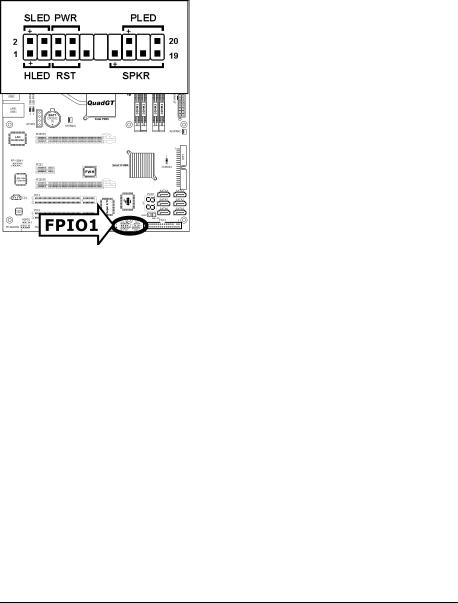
1.6.2 Front Panel Switches & Indicators Headers
This header is used for connecting switches and LED indicators on the chassis front panel.
Watch the power LED pin position and orientation. The mark “+” align to the pin in the figure below stands for positive polarity for the LED connection. Please pay attention when connecting these headers. A wrong orientation will only result in the LED not lighting, but a wrong connection of the switches could cause system malfunction.
•HLED (Pin 1, 3):
Connects to the HDD LED cable of chassis front panel.
•RST (Pin 5, 7):
Connects to the Reset Switch cable of chassis front panel.
•SPKR (Pin 13, 15, 17, 19):
Connects to the System Speaker cable of chassis.
•SLED (Pin 2, 4):
Connects to the Suspend LED cable (if there is one) of chassis front panel.
•PWR (Pin 6, 8):
Connects to the Power Switch cable of chassis front panel.
•PLED (Pin 16, 18, 20):
Connects to the Power LED cable of chassis front panel.
1-8 |
AB9 QuadGT |
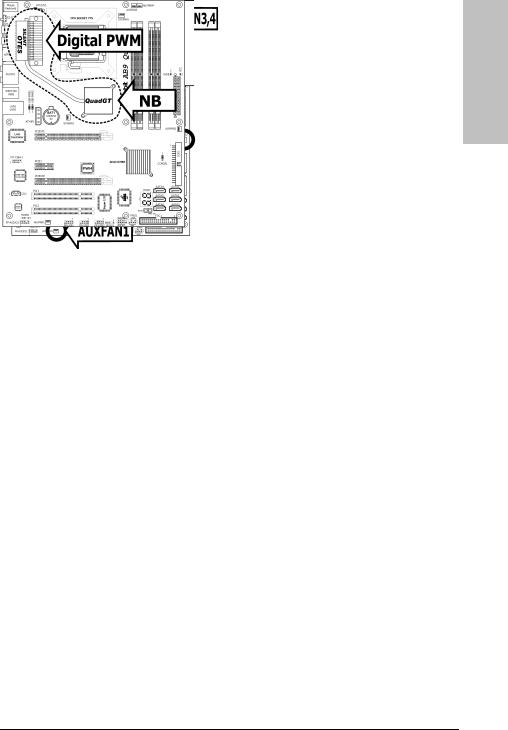
1.6.3 FAN Power Connectors
These connectors each provide power to the cooling fans installed in your system.
•CPUFAN1: CPU Fan Power Connector
•SYSFAN1: System Fan Power Connector
•AUXFAN1~4: Auxiliary Fan Power Connector
These fan connectors are not jumpers. DO NOT place jumper caps on these connectors.
1.6.4 abit Silent OTES™ Technology
The abit Silent OTES™ Technology tremendously condenses and dissipates the heatwave generated together from both the NB chipset and the digital PWM modules via a fin-type heatsink that is supposed to be fanned outward by the air flowed from the CPU cooler. DO NOT remove this heatsink.
Please take into consideration of the amount of high temperature that could possibly generated from the PWM modules if you intend to alter this design.
Setup Hardware
AB9 QuadGT |
1-9 |
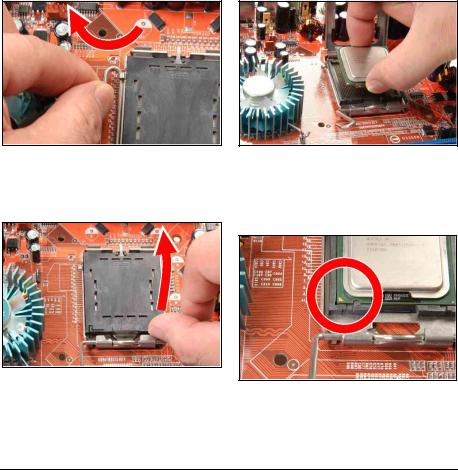
1.7 Installing Hardware
DO NOT scratch the motherboard when installing hardware. An accidental scratch of a tiny surface-mount component may seriously damage the motherboard.
In order to protect the contact pins, please pay attention to these notices:
1.A maximum 20 cycles of CPU installation is recommended.
2.Never touch the contact pins with fingers or any object.
3.Always put on the cap when the CPU is not in use.
1.7.1 CPU Socket 775
The installation procedures vary with different types of CPU fan-and-heatsink assembly. The one shown here is served for demo only. For detailed information on how to install the one you bought, refer to its installation guidelines.
1. Place the board so that the lever-hook of the socket is on your left side. Use your left thumb and forefinger to hold the lever hook, pull it away from the retention tab. Rotate the lever to fully open position.
3. Use your right thumb and forefinger to grasp the CPU package. Be sure to grasp on the edge of the substrate, and face the Pin-1 indicator toward the bottom-left side. Aim at the socket and place the CPU package vertical down into the socket.
2. Use your right-thumb to raise the load plate. Lift it up to fully open position.
4. Visually inspect if the CPU is seated well into the socket. The alignment key must be located in the notch of package.
1-10 |
AB9 QuadGT |
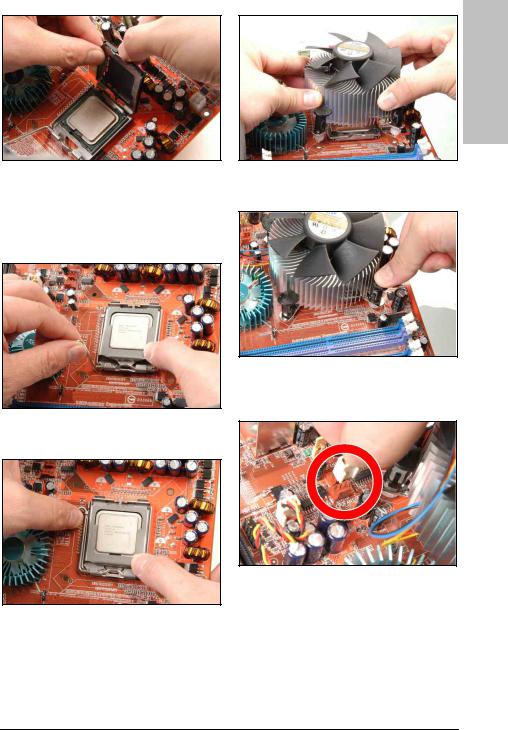
Setup Hardware
5. Use your left hand to hold the load plate, and use your right thumb to peel the cap off.
The cap plays an important role in protecting contact pins. In order to prevent bent pin, PUT ON the cap after operation or testing.
6. Lower the plate onto the CPU package. Engage the load lever while gently pressing down the load plate.
7. Secure the lever with the hook under retention tab.
8. Place the heatsink and fan assembly onto the socket. Align the four fasteners toward the four mounting holes on the motherboard.
9. Press each of the four fasteners down into the mounting holes. Rotate the fastener clock-wise to lock the heatsink and fan assembly into position.
10. Attach the four-pin power plug from the heatsink and fan assembly to the CPU FAN connector.
A higher fan speed will be helpful for better airflow and heat-dissipation. Nevertheless, stay alert to not touch any heatsink since a high temperature generated by the working system is still possible.
AB9 QuadGT |
1-11 |
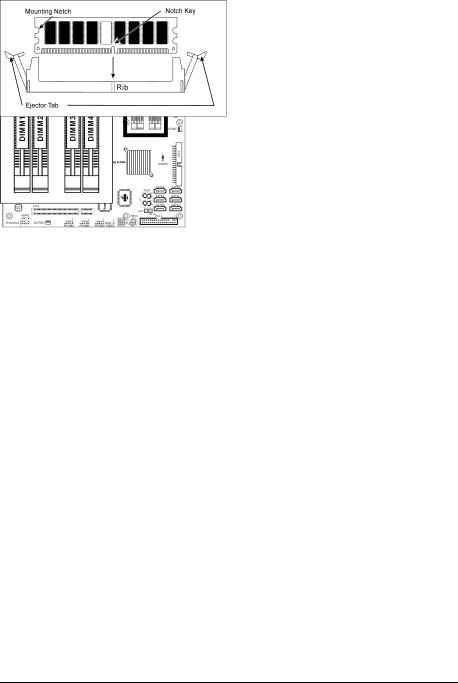
1.7.2 DDR2 Memory Slots
•To reach the optimum performance in dual-channel configurations, install identical DDR2 DIMM pairs for each channel.
•Install DIMMs with the same CAS latency. To reach the optimum compatibility, obtain memory modules from the same vendor.
Usually there is no hardware or BIOS setup required after adding or removing memory modules, but you will have to clear the CMOS memory first if any memory module related problem occurs.
To install system memory:
1.Power off the computer and unplug the AC power cord before installing or removing memory modules.
2.Locate the DIMM slot on the board.
3.Hold two edges of the DIMM module carefully, keep away from touching its connectors.
4.Align the notch key on the module with the rib on the slot.
5.Firmly press the module into the slots until the ejector tabs at both sides of the slot automatically snap into the mounting notch. Do not force the DIMM module in with extra force as the DIMM module only fits in one direction.
6.To remove the DIMM modules, push the two ejector tabs on the slot outward simultaneously, and then pull out the DIMM module.
Static electricity can damage the electronic components of the computer or optional boards. Before starting these procedures, ensure that you are discharged of static electricity by touching a grounded metal object briefly.
1-12 |
AB9 QuadGT |
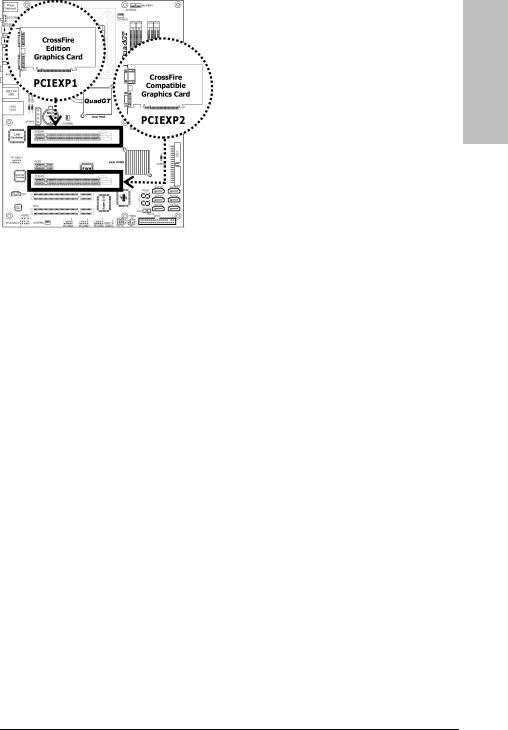
1.7.3 PCI Express X16 Add-on Slots (Install Graphics Card)
These slots support the connections of graphics cards that comply with PCI Express specifications. This motherboard provides dual PCI-Express X16 slots for one or two graphics cards installation:
One PCIE graphics card installation (Normal Mode):
Insert your PCIE graphics card into slot [PCIEXP1].
It is not recommended to install only one PCIE graphics card on the [PCIEXP2] slot, for such will pull the speed down to x4 only.
Two PCIE graphics cards installation (CrossFire Mode):
Install one CrossFire Edition graphics card
into [Master] slot (the slot PCIEXP1 on this motherboard), and one CrossFire Compatible
graphics card into [Slave] slot (the slot PCIEXP2 on this motherboard).
The ATI CrossFire™ technology currently supports the Microsoft Windows XP with Service Pack 2 only.
AB9 QuadGT |
1-13 |
Setup Hardware
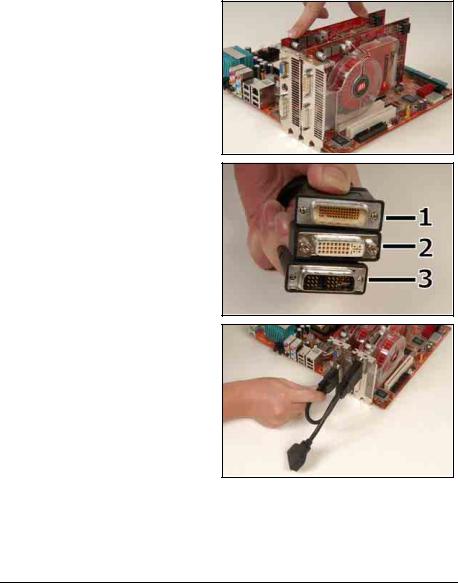
To enable CrossFire Mode, you will need to:
•Prepare one CrossFire Edition graphics card and one CrossFire Compatible graphics card.
•Make sure the graphics card driver supports the ATI CrossFire technology. Download the latest driver from ATI website (http://www.ati.com).
•Make sure your power supply unit is sufficient to provide the minimum power required.
1.Insert the CrossFire Edition graphics
card [Master Card] into the [PCIEXP1] master slot on motherboard.
2.Insert the CrossFire compatible PCI
Express graphics card (Slave Card) into the [PCIEXP2] slave slot.
3.There are 3 connectors on the DMS-59 -to-interconnect cable:
Connector 1: [DMS-59 ] Male connector Connector 2: [DVI-I] Female connector Connector 3: [DVI-I] Male connector
4.Connect the DMS-59 Male plug to the DMS-59 connector on Master Card.
5.Connect the DVI-I Male-end to the DVI-I connector on Salve Card.
6.Connect the video output to your monitor from the remaining DVI-I Female-end.
The motherboard in this illustration is served for demonstration only, may not be the same type or model as the one described in this user’s manual.
1-14 |
AB9 QuadGT |

1.8 Connecting Peripheral Devices
1.8.1 Floppy and IDE Disk Drive Connectors
Setup Hardware
The FDC1 connector connects up to two floppy drives with a 34-wire, 2-connector floppy cable. Connect the single end at the longer length of ribbon cable to the FDC1 on the board, the two connectors on the other end to the floppy disk drives connector. Generally you need only one floppy disk drive in your system.
The red line on the ribbon cable must be aligned with pin-1 on both the FDC1 port and the floppy connector.
Each of the IDE port connects up to two IDE drives at Ultra ATA/100 mode by one 40-pin, 80-conductor, and 3-connector Ultra ATA/66 ribbon cables.
Connect the single end (blue connector) at the longer length of ribbon cable to the IDE port of this board, the other two ends (gray and black connector) at the shorter length of the ribbon cable to the connectors of your hard drives.
Make sure to configure the “Master” and “Slave” relation before connecting two drives by one single ribbon cable. The red line on the ribbon cable must be aligned with pin-1 on both the IDE port and the hard-drive connector.
AB9 QuadGT |
1-15 |
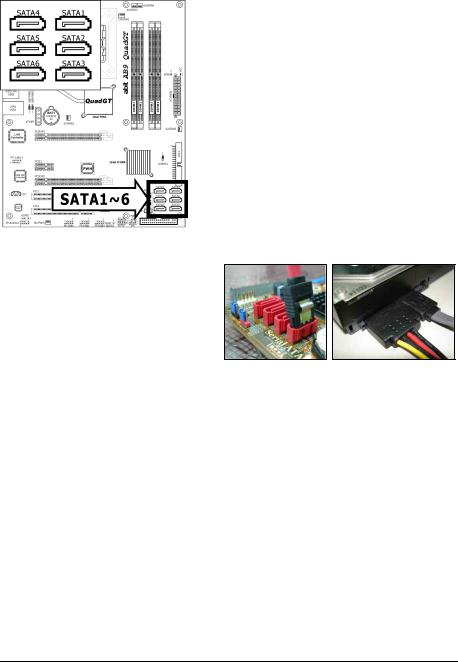
1.8.2 Serial ATA Connectors
Each SATA connector serves as one single channel to connect one SATA device by SATA cable.
To connect SATA device:
1.Attach either end of the signal cable to the SATA connector on motherboard. Attach the other end to the SATA device.
2.Attach the SATA power cable to the SATA device and connect the other end from the power supply.
The motherboard in this photo is served for DEMO only, and may not be the same type or model as the one described in this user’s manual.
1-16 |
AB9 QuadGT |
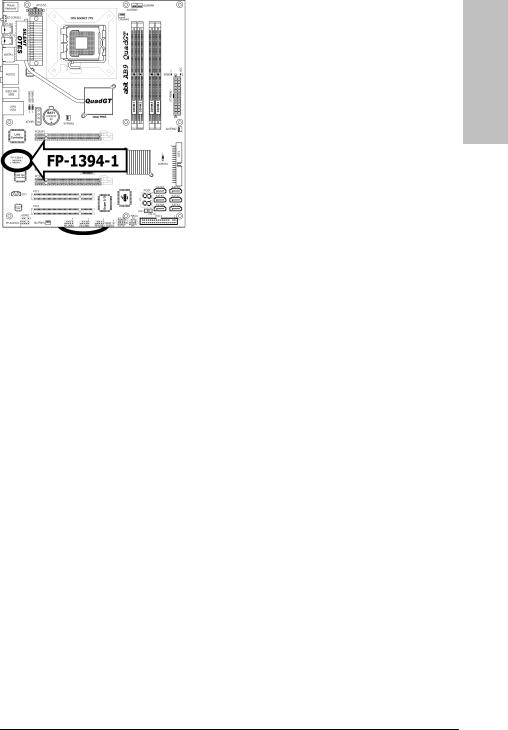
1.8.3 Additional USB 2.0 Port Headers
Each header supports 2x additional USB 2.0 ports by connecting bracket or cable to the rear I/O panel or the front-mounted USB ports of your chassis.
Pin |
Pin Assignment |
Pin |
Pin Assignment |
1 |
VCC |
2 |
VCC |
3 |
Data0 - |
4 |
Data1 - |
|
|
|
|
5 |
Data0 + |
6 |
Data1 + |
7 |
Ground |
8 |
Ground |
|
|
10 |
NC |
Make sure the connecting cable bears the same pin assignment.
1.8.4 Additional IEEE1394 Port Header
Each header supports 1x additional IEEE1394 port by connecting bracket or cable to the rear I/O panel or the front-mounted IEEE1394 port of your chassis.
Pin |
Pin Assignment |
Pin |
Pin Assignment |
1 |
TPA0 + |
2 |
TPA0 - |
|
|
|
|
3 |
Ground |
4 |
Ground |
|
|
|
|
5 |
TPB0 + |
6 |
TPB0 - |
7 |
+12V |
8 |
+12V |
|
|
10 |
Ground |
Make sure the connecting cable bears the same pin assignment.
Setup Hardware
AB9 QuadGT |
1-17 |

1.8.5 Internal Audio Connectors
This connector connects to the audio output of internal CD-ROM drive or add-on card.
1.8.6 Front Panel Audio Connection Header
This header provides the front panel connection for HD (High Definition) Audio, yet for AC’97 Audio CODEC connection, you must carefully check the pin assignment before connecting from the front panel module. An incorrect connection may cause malfunction or even damage the motherboard.
Please do not connect the “Ground” cable or “USB VCC” cable from the front panel module to the Pin 4 “AVCC” of this header.
Pin |
Pin Assignment |
|
(HD AUDIO) |
1 |
MIC2 L |
|
|
2 |
AGND |
|
|
3 |
MIC2 R |
|
|
4 |
AVCC |
|
|
5 |
FRO-R |
|
|
6 |
MIC2_JD |
|
|
7 |
F_IO_SEN |
|
|
9 |
FRO-L |
|
|
10 |
LINE2_JD |
|
|
Pin |
Pin Assignment |
|
(AC’97 AUDIO) |
|
|
1 |
MIC In |
|
|
2 |
GND |
|
|
3 |
MIC Power |
|
|
4 |
NC |
|
|
5 |
Line Out (R) |
|
|
6 |
NC |
|
|
7 |
NC |
|
|
9 |
Line Out (L) |
|
|
10 |
NC |
|
|
1-18 |
AB9 QuadGT |
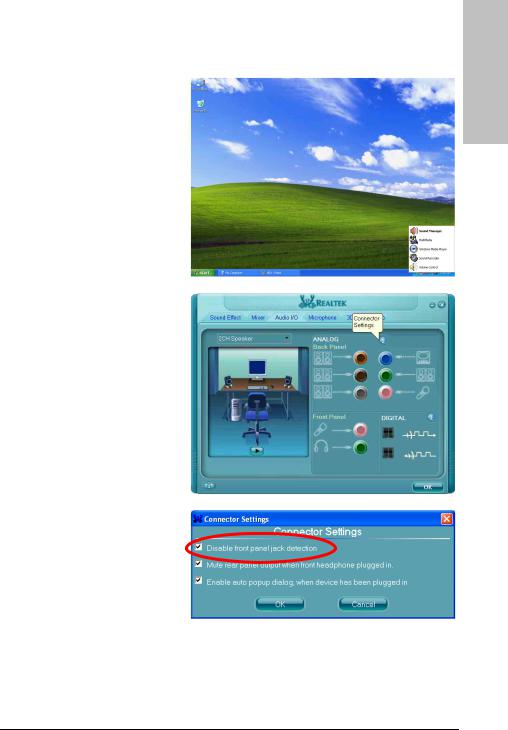
Driver Configuration for AC’97 audio connection:
The audio driver is originally configured to support HD Audio. For AC’97 audio connection, you may:
1.Right-click the “Realtek HD
Audio Manager” icon  in system tray.
in system tray.
2.Click “Audio I/O” tab, and then click “Connector Settings”.
3.Click “Disabled front panel jack detection”, and then click “OK” to confirm.
Setup Hardware
AB9 QuadGT |
1-19 |
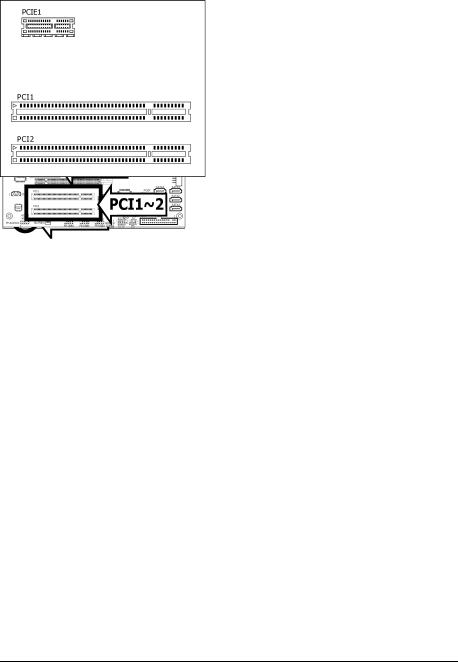
1.8.7 S/PDIF Output Connection Header
This header provides the S/PDIF output connection to your add-on HDMI VGA card.
Pin |
Pin Assignment |
1 |
VCC (5V) |
|
|
2 |
x |
|
|
3 |
S/PDIF Out |
4 |
Ground |
1.8.8 PCI and PCI Express X1 Slot
Install PCI Express X1 card into slot “PCIE1”.
Install PCI cards into slots “PCI1” and/or “PCI2”.
1-20 |
AB9 QuadGT |
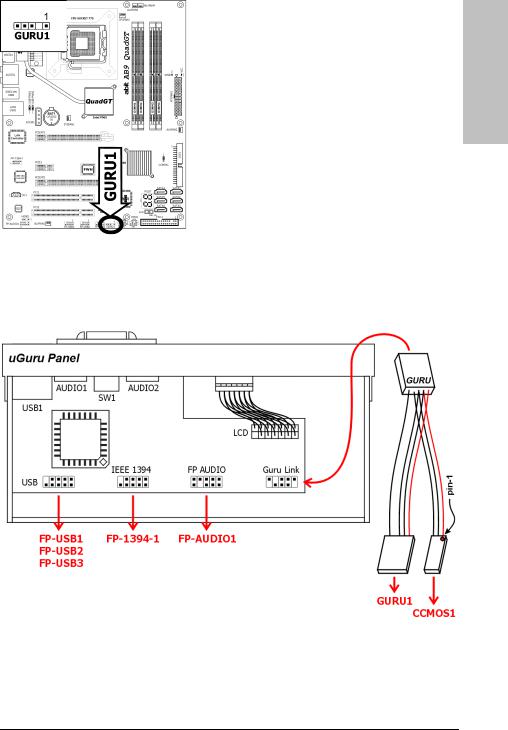
1.8.9 Guru Panel Connection Header
This header is reserved for connecting abit’s exclusive Guru Panel. For more information, please refer to the included Guru Panel Installation Guide.
Setup Hardware
AB9 QuadGT |
1-21 |
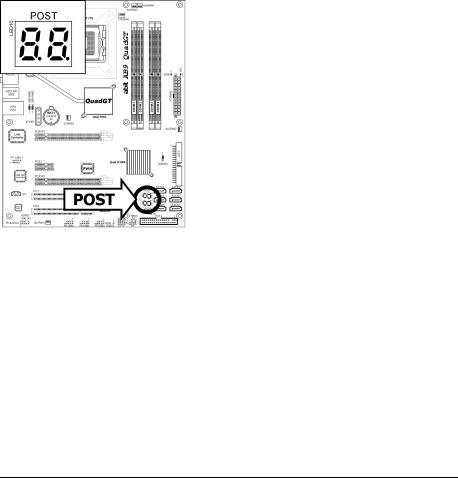
1.9 Onboard Indicators and Buttons
1.9.1 POST Code Displayer
This is an LED device to display the “POST” Code, the acronym for Power On Self Test. The computer will execute the POST action whenever you power on the computer. The POST process is controlled by the BIOS. It is used to detect the status of the computer’s main components and peripherals. Each POST Code corresponds to different checkpoints that are also defined by the BIOS in advance. For example, “memory presence test” is an important checkpoint and its POST Code is “C1”. When the BIOS execute any POST item, it will write the corresponding POST Code into the address 80h. If the POST passes, the BIOS will process the next POST item and write the next POST Code into the address 80h. If the POST fails, we can check the POST Code in address 80h to find out where the problem lies.
This LED device also displays the “POST” Code of AC2005, an “uGuru” chipset developed exclusively by abit.
The decimal point lights up during the AC2005 POST action.
See Appendix for both AWARD and AC2005 POST Code definitions.
1-22 |
AB9 QuadGT |
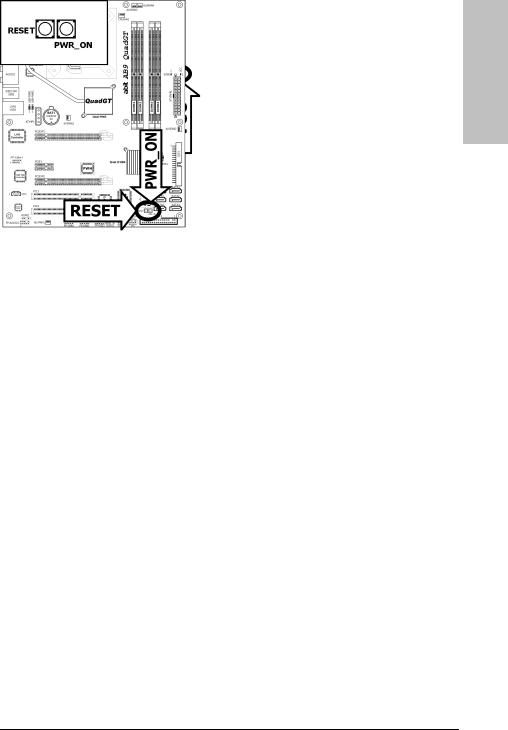
1.9.2 Power Source Indicators
•5VSB: This LED lights up when the power supply is connected with power source.
•VCC: This LED lights up when the system power is on.
1.9.3 Onboard Buttons
•PWR_ON: Push this button to power on the system.
•RESET: Push this button to reset the system.
Setup Hardware
AB9 QuadGT |
1-23 |
